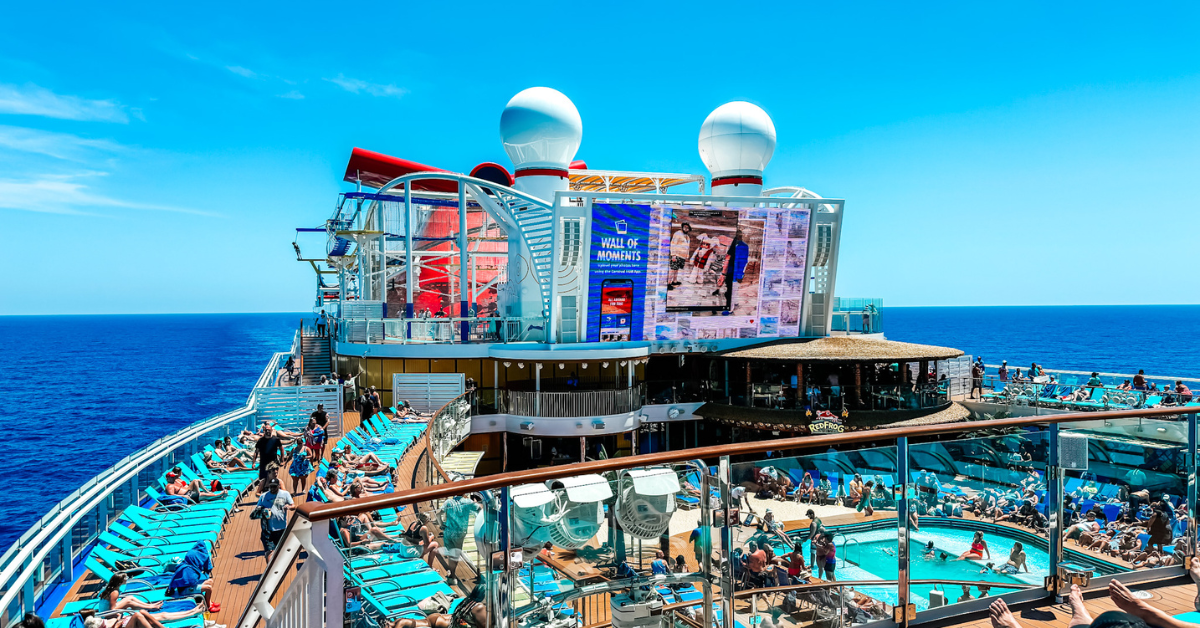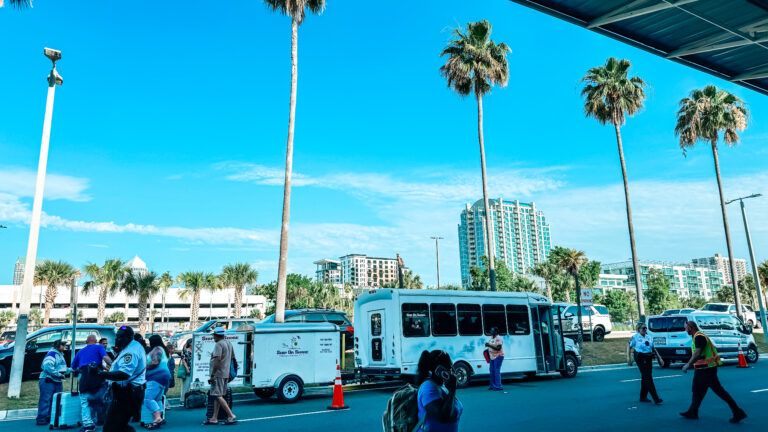Cruise Ship Tipping: Prepaid Gratuities, Extra Tips, and More

Planning a cruise involves more than just picking a destination and packing your bags. One crucial aspect some cruisers overlook is understanding the tipping culture. And I’ll admit—because cruises are billed as “all-inclusive,” and gratuities are generally required, on my first cruise, I just assumed that tipping in addition to those required gratuities wasn’t a “thing.” As someone who tends to be a generous tipper, I was embarrassed later to learn that while additional tips are certainly not required, they are customary…. well, somewhat.
Related: What’s included in cruise fare — and what’s not.
Cruise Gratuities: A Hot Button Issue

Before discussing cruise tips, I’ll say that there is no right or wrong answer regarding what is acceptable or whether or not to tip on top of the included gratuities. This is a personal choice, and approaches to it vary widely from cruiser to cruiser.
This can be a controversial and very subjective topic. You’ll find some cruisers who staunchly oppose additional tipping and others who tip generously in addition to the included gratuities. I spend a lot of time on cruise social media groups, so I see this debate regularly. The guidance that I’m about to provide is drawn from both my personal experiences and the general consensus that I see within these groups.
Included Gratuities
First, let’s talk about included gratuities. Unless you’re sailing on Virgin Voyages, where everything truly is (mostly) all-inclusive, including gratuities, part of the compensation for cruise ship employees comes from tips. Most major cruise lines, including Celebrity, Holland America Line, Carnival, Princess, Royal Caribbean, and others, have a policy of automatically adding a predetermined gratuity amount to your onboard account. These are the included gratuities.
What are Prepaid Gratuities?
It can be confusing because these included gratuities are sometimes called prepaid gratuities. Cruise lines often ask, and some even encourage, cruisers to pay the included gratuities when they book and pay for their cruise. Cruisers who opt not to pay gratuities in advance will see that charge hit their stateroom account generally on the last evening of their sailing.
So, is it required that cruisers prepay for included gratuities? No, and I personally never do. I see no benefit at all in paying for something before I have to. Plus, as a business professor, I always get stuck on the concept of the time value of money (nerd alert!). Should you have to cancel your cruise, prepaid gratuities are generally refundable, but I’d rather not have to deal with trying to get a refund if I need to cancel by not having prepaid gratuities at all.
Can I Have Gratuities Removed From My Bill?
Passengers can decline this automatic gratuity charge and instead choose to either not tip at all or to tip directly, according to their preferences. However, to do so, they must inform the front desk of their decision, and some cruise lines, like Carnival, will not allow cruisers to make this request until the final night of the sailing.
So if you see an insanely long Guest Services line on the last night of your cruise, that’s usually it. It’s a long line of cruisers who intend to have gratuities moved from their stateroom bill. Unless this request is specifically made, or the required gratuities were already prepaid, the charge will be included on the cruisers’ final bill and charged to the credit card on file.
How Much are Required Gratuities and Who Gets Them?
Required gratuities are calculated on a per-passenger, per-day basis, typically ranging from $11.50 to $16 per person per day. The funds collected are then distributed according to the cruise line’s predetermined allocation formula among various onboard personnel, including cabin stewards, bartenders, baggage handlers, restaurant staff such as waiters, and other lower-paid staff members.
The value of included gratuities is ensuring that it’s not just customer-facing staff who benefit from cruiser tips. There are many behind-the-scenes staff and crew who work hard to ensure a great guest experience on your cruise who you might never cross paths with and, therefore, would never tip directly. Here are some cruise staff positions that cruisers commonly choose to tip:
Room Steward
Your room steward, or stateroom attendant, is the crew member responsible for maintaining and servicing guest accommodations aboard a cruise ship, ensuring cleanliness and comfort, and addressing guest needs during their sailing. Most cruisers who choose to tip in addition to the required gratuities opt to do so for their room steward, given how hard they work, how visible their work is, and how personable these staff generally are in getting to know cruisers and remembering their names.
I personally tip around $20 per person for the week for shorter sailings, up to 5 nights, and more for longer sailings. This is per sailing, not per night. So if it’s just me and my two kids sailing, I’ll tip $60. Some cruisers choose to tip nothing, some tip less, and some tip more. Again, there is no right or wrong, nor is there a standard. If I get exceptional service, I tip more.
Not only is the subject of whether to tip and how much to tip highly debated but there’s even discussion about when to tip. Some cruisers are convinced that tipping their steward on the first day is best, as it ensures enhanced service during the sailing, whereas others prefer to wait until the end once they have determined that the service rendered was quality enough to deserve an additional gratuity.
As for me, I generally do a split. I tip my steward $20 that first day. Room stewards generally attempt to meet the guests staying in their assigned staterooms on the first day, although this isn’t always possible if you’re barely in your stateroom on day one. When I meet my steward the first time, I tip $20 and assure them that “there will be more later.” I then leave the remainder of my tip in my room the last night.
Porter
A porter is an employee at the cruise terminal responsible for assisting passengers with luggage handling and ensuring smooth embarkation and disembarkation processes. If you choose to check your bags, you will drop them off curbside to a porter. Many cruisers choose to tip porters, anywhere from a buck or two per bag, or a larger sum for all bags within their party. I generally tip $2 per bag, which is fairly customary, although it’s good practice to tip more if you have really heavy or oversized bags.
MDR Waitstaff
I typically choose flexible dining in the Main Dining Room (MDR), meaning I have a different wait team most nights, so I generally tip a couple of bucks after each meal. If I have set dining and enjoy the benefit of having the same wait staff team each night, I will generally tip on the last evening, around $20 per person in my party for the entire sailing, and I hand this directly to the main waiter with the instruction to share that with their assisting wait staff.
Buffet Waitstaff
Tipping the buffet waitstaff is much less common compared to other cruise staff roles, primarily because the interaction is minimal and the service is more behind the scenes. Personally, I find it thoughtful to leave behind a dollar or two for the buffet waitstaff after dining in the buffet, especially if I’ve noticed them providing exceptional service.
For instance, if a staff member has been particularly attentive in quickly clearing my plates or helping me find a seat during busy meal times, I like to show my appreciation. This small token can make a big difference for the hardworking crew members who often go unnoticed in the bustling buffet environment.
Beverage Service
Enjoying a nice drink is one of the many pleasures of cruising, whether it’s a specialty coffee to start your day or a cocktail to unwind in the evening. This is especially the case if you bought the drink package! Beverage service happens in many locations on the ship: bars, lounges, casinos, poolside, specialty cafes, and others.
When it comes to tipping for beverage service, tipping a dollar or two per drink is customary. Be careful, however, to first check, as sometimes an automatic 18% gratuity is already included on your tab and you may not want to inadvertently double tip.
Tipping for beverage service can sometimes be a strategic move, rather than one motivated simply by wanting to reward good service. With cruise line staff cutbacks in recent years, it can sometimes prove challenging to get timely beverage service, especially in hot spots like the casino or pools. Tipping generously upon receipt of your first drink can go a long way in making sure the service staff remember you and make you a priority.
Excursion Providers
Excursions are a fantastic way to explore ports of call, offering everything from guided city tours to adventurous activities. If you hire a private driver, they often provide a personalized experience, taking you to hidden gems and offering local insights. For such services, I typically tip around $20 per person, adjusting based on the quality and length of the service.
Similarly, for guided tours, where the guide shares detailed narratives and ensures a smooth experience, a $20 tip is standard, with more for exceptional service. Adventure excursions, like snorkeling or zip-lining, also warrant a similar tip to acknowledge the specialized guidance and support.
Always carry cash for cruise tips, as not all guides or drivers accept cards. Even in foreign ports of call, tips in US currency are generally enthusiastically accepted. When deciding the tip amount, consider the service quality, group size, and tour length. Tipping generously enhances your experience and supports the hard-working individuals who make your excursions memorable.
How Much Money to Bring on a Cruise
It’s impossible to provide one-size-fits-all advice about how much money to bring on a cruise, as it’s so subjective and varies widely from person to person. Instead of giving you an amount, below are the things that you can plan to spend money on, and then determine what you think you will spend in each of these categories to devise a total planned budget. But first, let’s talk about the issue of cash and whether it’s needed.
Is Cash Needed on a Cruise?
A convenience of cruising is that all of your onboard charges are simply billed to the card attached to your stateroom account. So on the ship, other than optional tips (detailed above), it’s essentially a cashless experience. Therefore, it’s unnecessary to worry too much about having cash on hand while you’re on the cruise ship (aside from tips). Having cash for your visits to ports of call, however, is advisable. More on that in a moment.
Is It Necessary to Convert Currency for a Cruise?
Most ports are commercialized and accustomed to American travelers, so it’s usually not necessary to convert US currency to foreign currencies. This is especially true for itineraries that are called upon from sailings that originate and end from the US, like Caribbean cruises. This will obviously differ if you’re embarking on a sailing from an international port.
Most port vendors accept US currency, credit, and debit cards, although depending on the terms of your cards, you may incur an international transaction fee. Also, while most ports of call on sailings that disembark from the United States accept US currency, some of them, especially smaller Caribbean islands, may accept US currency only if the bills are in good condition. This means no rips or tears, bills are not overly worn, and there is no writing on the bills. Further, while they may accept US currency, they may provide change back in the form of the local currency.
Budgeting For Cruise Expenses
When budgeting for your cruise, both how much cash to bring and how much you aim to spend overall, below are some general categories. Consider each one, evaluate what you plan to spend, and calculate your personal cruise spending budget accordingly.
Tips
As noted above, if you choose to tip employees on your cruise in addition to the included gratuities, or service providers on your port day excursions, you’ll want to bring cash, including lots of singles and small bills.
Excursions
If you book an excursion through the cruise line, the charge will be billed to your stateroom account, or prepaid if you booked in advance. If you book with an independent tour provider, you’ll either pay in advance or on the day of your excursion. If paying on the day of your excursion, note that some tour operators only take cash, so verify this with them in advance.
I once booked an excursion in Belize and assumed they would take my credit card as payment, only to end up in a sticky spot when I realized only then and there, at the excursion location (far away from any ATM machine), that it was a cash-only situation and I didn’t have enough cash on hand. I was able to work it out, but that was a very stressful moment that could have ended in a ruined port day.
Taxis
Many taxi services at cruise ports accept cards, but this is not a guarantee. Even taxi providers at wildly busy ports that are highly commercialized, such as Cozumel, do not typically accept cards as payment. And for the less developed ports of call, like Progreso and Costa Maya, it’s almost guaranteed that taxi drivers will take cash only.
Souvenirs
This is a hugely variable expense, but know that while most port souvenir vendors will take cards, paying cash might save you money, as the vendor may give you a discount for doing so. You will likely also enhance your negotiation leverage by paying in cash, as this allows the vendor to avoid paying credit card transaction fees.
Extras
While cruises are “all-inclusive”, the cruise lines make a lot of money by upselling cruisers on a variety of extras once they’re on board. This includes things like photos, wifi, casino expenditures, specialty dining, and more. Some of these things can be prepaid, but if you did not pay in advance, budget for these as part of your cruise planning process. Also, unless you plan to only eat on the ship, and plan your meals around your time in port, you will likely incur costs associated with food and drinks on port days.
Tipping is Subjective
Exploring the intricacies of tipping and managing money on a cruise can make for a smoother experience. While this advice is generally applicable, I again want to stress the personal nature of both tipping and financial planning for expenses at port destinations and note that there is no one-size-fits-all approach. Use these guidelines to tailor your spending and tipping habits to suit your preferences and enhance your cruise adventure.






